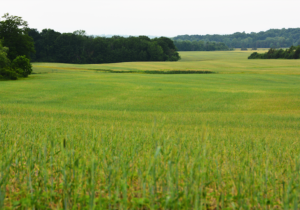Remineralization Goes Mainstream: Major media outlets recognize the power of rock dust
Application of silicate material to cropland. Beerling et al. demonstrate that enhanced rock weathering, achieved by adding crushed basalt or other silicate material to soil, is an effective strategy for removing carbon dioxide from the atmosphere. Photo by: Ilsa B Kantola
break
Last year, the journal Nature published an immensely-popular study on remineralization. With more than 20,000 views, this article may be the most widely-read paper on enhanced weathering to date, and several major media outlets have picked up on it as well.

Benjamin Houlton, Ronald P. Lynch Dean of the College of Agriculture and Life Sciences at Cornell University. Photo by: Lisa Howard, UC Davis
In The Washington Post, Lindsay Layton explains clearly: “Spreading rock dust on the ground could pull carbon from the air.” The Guardian estimated “vast amounts of CO2” could be removed, while Smithsonian touted rock dust as “farming’s next climate solution.”
In a recent NPR segment, heard on the Morning Edition, Chris Reinhard, who teaches earth and atmospheric sciences at Georgia Tech, highlighted the benefits of using crushed basalt over limestone to balance pH levels in fields, as well as sequestering atmospheric CO2. Meanwhile, an opinion article in The Hill suggests that between 0.5 to 2 billion tons of CO2 could be removed each year if rock dust fines were applied to all croplands on the planet. The article describes remineralization as “one of the most promising approaches” to hit the “sweet spot” between facing economic realities and maximizing permanent carbon dioxide removal.
Unreservedly, The Huffington Post called this technology, “The Soil Revolution That Could Save Farming And The Climate.” Great news for our movement, this overwhelmingly positive mainstream publicity signals remineralization entering public awareness like never before.
In this article, The Huffington Post interviewed a veteran in the field, Tom Vanacore, who is on the Board Advisors of Remineralize the Earth. Vanacore “realized in the 1980s that mineral-rich dust from basalt and shale quarries could replenish nutrients in soil.” To him and other farmers, remineralization made sense because it helped them grow organically, providing a broad spectrum of trace minerals.
Remineralization is often viewed and practiced as a piece of a holistic, regenerative agriculture puzzle. The reduction of synthetic fertilizers and pesticides, no-till planting, and other techniques synergize with rock dust application, so it just makes sense to integrate them. Vanacore has always seen modern farming practices as destructive to the living ecosystem of soil, whereas “rock dust is the jumpstart” in the transition to regenerative agriculture.
Less tilling means less disturbance to soil’s microbial life, and rock dust provides inorganic nutrients that help those fungi and bacteria flourish. The microbes sustain healthy soils, which grow bigger and healthier plants, pulling more carbon from the air and producing more nutritious food.
The major environmental benefit of remineralization that the recent Nature article focuses on is the chemical breakdown and sequestration of CO2 that occurs when it encounters a mineral such as silicate rock: “enhanced weathering” transforms carbon from a greenhouse gas into bicarbonate, which dissolves in water and can remain trapped in that form for over 100,000 years.
Enhanced weathering is what holds promise for large-scale carbon sequestration via remineralization. Natural rock weathering has occurred on Earth for millennia, but remineralization by humans creates the ideal conditions for minerals to interact with the air and water. The general term, “weathering” can refer to larger physical processes, such as cliffs being carved out by waterfalls, as well as the microscopic process of chemical weathering. Carbon dioxide comes into contact with minerals in a variety of ways, but water is a major conduit.

Hudson Valley’s Stone House Farm, where remineralization is in practice.
In a body of water, dissolved CO2 impacts minerals that are dissolved in the water, as well as on the bed beneath. In agricultural fields, rain and added water capture CO2 in the air and transport it into the soil. Also, plant roots assist with weathering, both by physically breaking down rocks, and also by secreting chemical compounds such as acids and CO2, dissolving minerals and capturing carbon in the soil. Even fungi and bacteria, which you may remember benefit from remineralization, assist with weathering those minerals.
There are even more reasons why remineralization and regenerative agriculture go hand-in-hand. As far as carbon drawdown techniques go, one benefit of enhanced weathering is that it “does not compete with food for land.” Indeed, remineralization does not compete with anything for land, whereas negative emissions via solar panels, for example, may contest with forested or agricultural land. Furthermore, farms in particular offer some of the greatest potential for remineralization, because years of conventional agriculture have left much of those soils depleted.
While remineralization is a natural process, it can take the Earth millennia to mineralize soils via glaciers, for example. Although agriculture and other human impacts can deplete trace minerals much more quickly than that, it is fortunate that we can also regenerate soil using crushed rock. “‘The more we looked into it, the more it seemed like a no-brainer,’ said David Beerling, a soil researcher at the U.K.’s University of Sheffield and the lead author of the [Nature] study.”
The power of remineralization is no longer an obscure technique used only by a small group of organic farmers, or a research program known only to the environmental science community. Remineralization is going mainstream, as highlighted in its recent acknowledgements by reputable, major media outlets. The next step is turning knowledge into action, and galvanizing a widespread movement around this important tool in the fight against climate change. The time for action is now.
break
References
- Beerling, David J., Euripides P. Kantzas, Mark R. Lomas, Peter Wade, Rafael M. Eufrasio, Phil Renforth, Binoy Sarkar, et al. (2020, July 8) “Potential for Large-Scale co2 Removal via Enhanced Rock Weathering with Croplands.” Nature News. https://www.nature.com/articles/s41586-020-2448-9.
- Layton, Lyndsey. (2020, July 8) “Spreading Rock Dust on the Ground Could Pull Carbon from the Air, Researchers Say.” The Washington Post. https://www.washingtonpost.com/climate-solutions/2020/07/08/spreading-rock-dust-ground-could-pull-carbon-air-researchers-say.
- Kaufman, Alexander C. (2020, September 25) “The Soil Revolution That Could Save Farming and the Climate.” HuffPost. https://www.huffpost.com/entry/climate-change-regenerative-farming_n_5f6cba7ec5b653a2bcb1550f.
- Carrington, Damian. (2020, July 2020) “Spreading Rock Dust on Fields Could Remove Vast Amounts of CO2 from Air.” The Guardian. https://www.theguardian.com/environment/2020/jul/08/spreading-rock-dust-on-fields-could-remove-vast-amounts-of-co2-from-air.
- Bugos, Claire. (2020, July 21) “Rock Dust Could Be Farming’s Next Climate Solution.” Smithsonian. https://www.smithsonianmag.com/smart-news/rock-dust-climate-180975363/.
- Porder, Stephen. (2019) “How Plants Enhance Weathering and How Weathering Is Important to Plants.” Elements 15, no. 4 : 241–46. https://doi.org/10.2138/gselements.15.4.241.
- Ahl, Jonathan. (2021, Sept. 21) “Researchers Suggest A Different Way For Farmers To Reduce Their Carbon Footprint. National Public Radio. https://www.npr.org/2021/09/21/1039191137/researchers-suggest-a-different-way-for-farmers-to-reduce-their-carbon-footprint.
- Houlton, Benjamin, Garrett Boudinot. (2021, Sept. 21) “Rock Dust Could Put A Drain On Atmospheric Carbon — Will This Technology Work?” The Hill. https://thehill.com/opinion/energy-environment/573084-rock-dust-could-put-a-drain-on-atmospheric-carbon-will-this.
Support us on Patreon
Thank you for joining us today! Please become a member of RTE and support us on Patreon. Unlike many larger organizations, we work with a team of determined and passionate volunteers to get our message out. We aim to continue to increase the awareness of remineralization to initiate projects across the globe that remineralize soils, grow nutrient dense food, regenerate our forests’ and stabilize the climate – with your help! If you can, please support us on a monthly basis from just $2, rest assured that you are making a big impact every single month in support of our mission. Thank you!









Jacques Snyman
December 6, 2021 (1:10 am)
Been working with remineralising soil by applying basalt rock dust in South Africa for over 20 years….
Best results are achieved in a natural, organic system, where soil microbes and mycorrhizael fungi make the rock minerals plant available….
In conventional setups, where NPK fertilisers are used on bioligically dead soils, with little or no organic matter, there is little benefit….